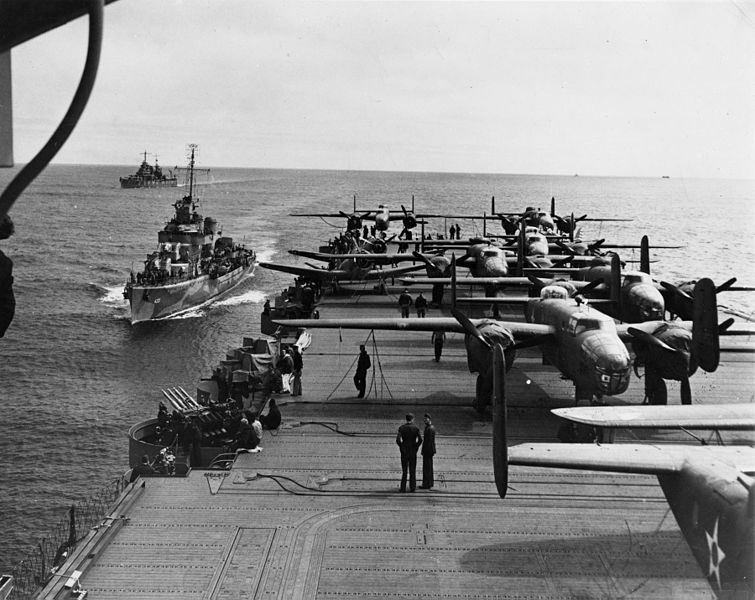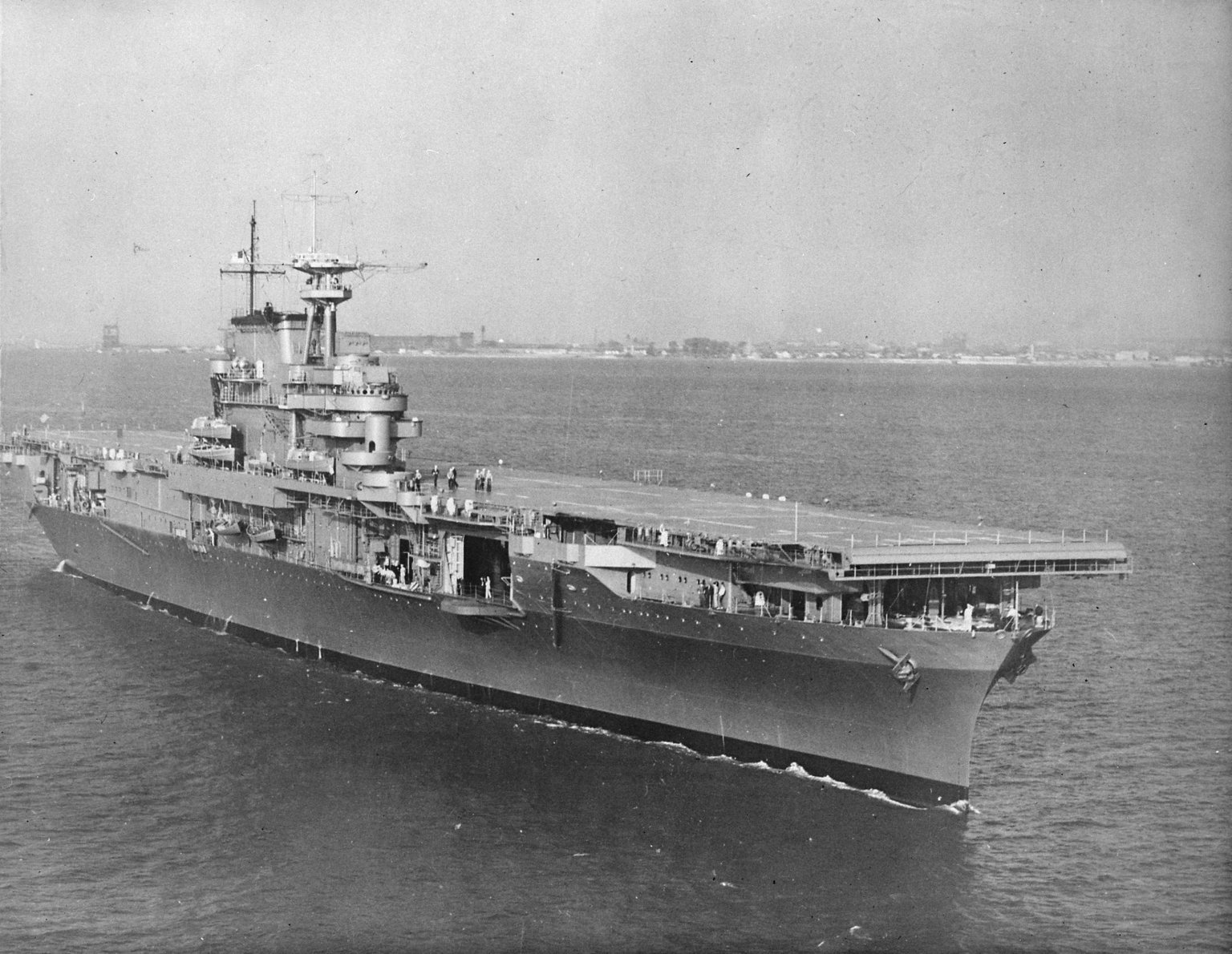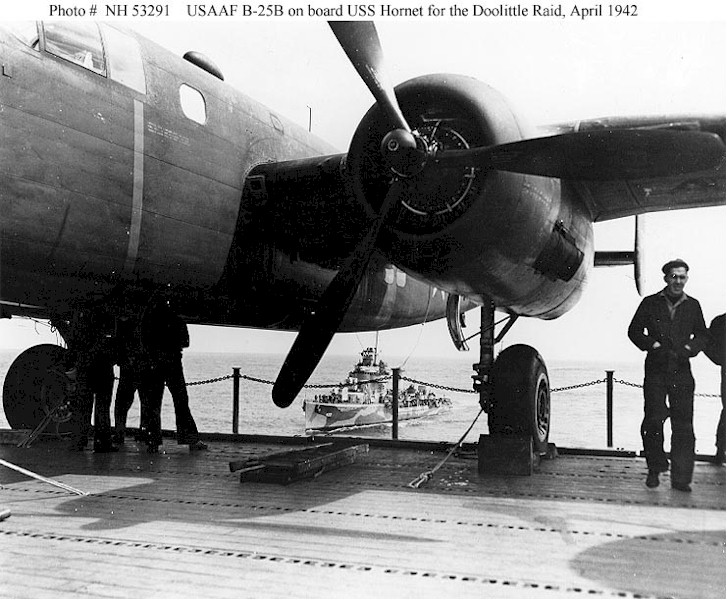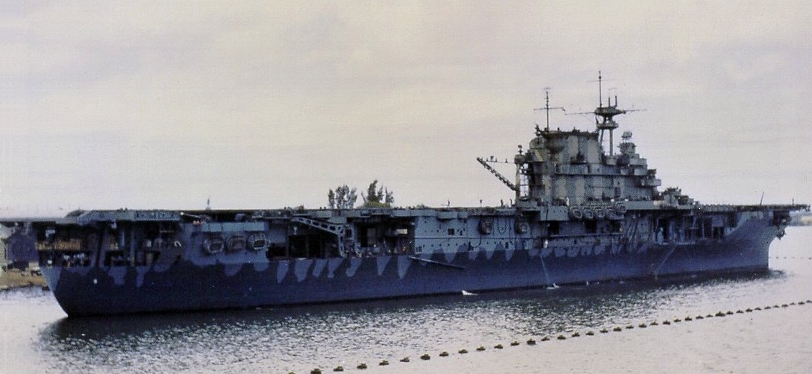
2 April 1942: After loading sixteen North American Aviation B-25B Mitchell medium bombers and their crews of the 17th Bombardment Group (Medium) at NAS Alameda, the recently commissioned United States Navy aircraft carrier USS Hornet (CV-8) departed San Francisco Bay with her escorts and headed for a secret rendezvous with Vice Admiral William F. Halsey, Jr., and Task Force 16.
The new carrier was under command of Captain Marc A. Mitscher. The strike group was commanded by Lieutenant Colonel James H. (“Jimmy”) Doolittle, U.S. Army Air Corps. Until the second day at sea, only six U.S. military officers knew of the mission.
The photograph above shows some of the bombers secured on Hornet‘s flight deck. An escorting destroyer, USS Gwin (DD-433) is closing from astern, with light cruiser USS Nashville (CL-43) in the distance. Two more ships are on the horizon.

USS Hornet was a brand new Yorktown-class aircraft carrier, commissioned 20 October 1941. It had just completed its shakedown cruise in the Atlantic when it was sent west for this mission.
The ship was 824 feet, 9 inches (251.384 meters) long, overall, with a maximum width of 114 feet (34.747 meters). Hornet‘s dimensions at the waterline (full load displacement) were 761 feet (232 meters) long with a beam of 83 feet, 3 inches (25.375 meters). Its draft was 28 feet (8.5 meters).
The flight deck had two hydraulic catapults, and three elevators for bringing aircraft up from the hangar deck. A third catapult was on the hangar deck, launching aircraft laterally.
Powered by four geared steam turbines driving four propeller shafts, Hornet‘s engines produced 120,000 shaft horsepower. The carrier’s maximum speed was 33.84 knots (39.94 miles per hour/62.67 kilometers per hour), and maximum range, 12,500 nautical miles (14,385 kilometers).

The aircraft carrier’s primary armament was its air wing, consisting of a squadron each of Grumman F4F Wildcat fighters, Douglas SBD Dauntless dive bombers and Douglas TBD Devastator torpedo bombers. For the Halsey-Doolittle Raid, Hornet‘s air wing was stored on the hangar deck and unavailable.
“To make room for the Army bombers, Hornet had struck her own planes below. Wildcats and Devastators, with wings folded, and dismantled SBDs were packed into every available space, even hung from the overhead. So, except for her few guns, the carrier was defenseless until she rendezvoused with Task Force 16. . . .”
—History of United States Naval Operations in World War II, Volume III, The Rising Sun in the Pacific, by Samuel Eliot Morison, Little, Brown & Company, Boston, 1988, Chapter XX at Page 392.
For defense, the ship was lightly armored, with 2.5–4 inches (6.35–10.2 centimeters) of belt and deck armor. She also carried eight 5-inch, 38-caliber (5″/38) dual-purpose guns in single mounts, thirty 20mm Oerlikon autocannon, twenty water-cooled 1.1-inch, 75-caliber (1.1″/75) guns in four-gun mounts, and twenty-four Browning .50-caliber (12.7 millimeter) machine guns.
Including the ship’s air wing, the complement was 2,919 men.
USS Hornet fought at the Battle of Midway, June 3–7, 1942. She was sunk at the Battle of the Santa Cruz Islands, 26 October 1942, having been hit by two airplanes, 8 bombs, 16 torpedoes and an unknown number of 5-inch shells.¹

¹ The research vessel R/V Petrel located the wreck of USS Hornet on the sea floor in January 2019. The ship lies at a depth of 5,330 meters (17,487 feet).
© 2019, Bryan R. Swopes
Great entry! I would love to know three things: 1) how long have historians been calling it the Halsey-Doolittle Raid; 2) which plane was Halsey on; and 3) what Dick Cole thinks of the renaming? Some alternative history: if, after being spotted some 400 miles short of the planned launch point, they had jettisoned the bombers overboard for Hornet’s safety, what would they be calling the failed raid today? With all due respect to the sacrifices and accomplishments of our US Navy.
Colonel Boyington, you and I have debated this point in the past. I am not going to change your opinion, nor you, mine. To answer your question, the first reference that I have in my personal library is September 1948, History of United States Naval Operations in World War II, Volume III, The Rising Sun in the Pacific 1931–April 1942, by Rear Admiral Samuel Eliot Morison, Ph.D., U.S. Navy, Little, Brown and Company, Boston, 1948, Chapter XXI, Section 2, at Page 389.
Admiral Morison, then a lieutenant commander, began his World War II research in May 1942. The Smithsonian Institution has called him “the pre-eminent historian of his generation,” and his 15-volume history a “masterwork.”
I have not had the honor of communicating with Mr. Cole, so I am not aware of his opinion, if any, in the matter.
I assume that your following question is facetious. As I am sure you know, Vice Admiral Halsey commanded the operation from his flagship, USS Hornet (CV-8), not one of the 178 airplanes involved in the operation. They were not spotted “some 400 miles short of the planned launch point,” but 150 miles. Halsey’s Task Force 16 charged ahead for another 41 minutes before the first B-25, Lieutenant Colonel Doolittle’s B-25B 40-2344, was launched at 0725, and continued westward until the 16th bomber, Lieutenant Farrow’s 40-2268, left Hornet’s deck at 0824, 1 hour, 40 minutes after the third presumed sighting. Only then did Admiral Halsey order the task force to change course. The United States Navy did NOT jettison the Army’s bombers and beat a cowardly retreat.
“This Day in Aviation” will continue to refer to the operation as “The Halsey Doolittle Raid.” I understand that you dislike that title and find it “insulting.” Your opinion is noted. You may call the the raid anything that you like in your own Internet blog. You can rest assured that I will not quibble with you over your choice.
Respectfully yours,
Bryan R. Swopes
It should noted that a Naval aviator named Hank Miller was also instrumental in concept of raid and actually helped train pilots for raid . Not hardly mentioned anywhere in reference to raid . He and Jimmy Doolittle were very close friends and remained so to end of life .
Here is my familial connection to the Doolittle Raid.
Early on the morning of 18 April 1942, the USS Ranger, carrying the 16 B-25 Mitchell bombers and their crews toward Japan, received a flashing light message from the USS Enterprise that two enemy ships had been spotted on radar. The formation was turned away from their course to avoid being seen and the radar contacts faded.
From Daniel Dickel’s blog on September 14, 2014,
“At 05:08 the dawn search flight patrol consisting of eight F4F Grumman fighters and three SBD Douglas scout bombers took to the air from the Enterprise to search to a distance of two hundred miles. Three more scout bombers were launched for a combat air patrol above the Task Force.
The weather, which had been moderately rough during the night, was worsening. Low broken clouds hung over the area; frequent rain squalls swept over the ships and the sea began to bellow up in 30 foot crests. Gusty winds tore the tops off the waves and the spray blew across the decks of the ships, drenching the deck crews.
The three SBD pilots climbed to the bottom of the broken clouds in a “single plane relative search.” At 05:58, Lieutenant O. B. Wiseman sighted a small patrol craft. He quickly reversed course for the Enterprise. Fixed his position as best he could on his small plotting board, he jotted down a message:
Enemy surface ship–latitude 36-O4N, Long. 153-10E, bearing 276˚ true–42 miles. Believed seen by enemy.
Wiseman handed the message back to the gunner in the rear seat and make a throwing motion with his hand.
The gunner knew what to do. He reached in his pocket for a bean bag message container, stuffed the paper inside and peered over the side as Wiseman dived for the Big E’s flight deck. Wiseman put flaps down to slow his plane and the gunner opened the canopy. When the SBD was directly overhead, the message plopped down on the deck and was scooped up on the run by a deckhand and delivered to Halsey on the bridge.” http://kd0nhm.blogspot.com/2014/05/launch-planes.html
Admiral Halsey immediately ordered the Doolittle Raiders to launch.
LT Wiseman, a cousin of my grandfather’s, and his gunner/radio operator, Aviation Radioman Second Class Grant Dawn, were lost at the Battle of Midway after participating in the sinking of the Japanese aircraft carriers Siryu and the Horyu. For his valor, LT Osborne B. Wiseman was awarded the Navy Cross and the USS Wiseman, DE-667, a destroyer escort, was named in his honor. https://chescoheroes.org/786/Wiseman-Osborne-B
The raid was the greatest move. It sent a clear message to the enemy that they were about to reap far more than they ever thought they would ever know.
All these hero’s set in motion a wind that would blow Japan away. God bless them all.
Interesting. I don’t think I ever noticed any other planes on Hornet’s deck beside the Mitchells. First photo shows 2 Wildcats tied down on the starboard edge of the deck in front of the last B-25. Must have run out of room below because they sure couldn’t use them until the bombers were gone.
Steve, they had Wildcats hanging from the overhead on the hangar deck.
Steve. Actually, I believe those two are Douglas TBDs.
I had no idea the USS Hornet had a catapult in the hangar decks that launched laterally. That blew my mind.
Commissioned in Oct 41, shakedown cruise done, embarked on significant cross-Pacific mission Apr 42. Now we can’t fix new carriers after four or five years of trying.
@ William Wiseman – Your second sentence states the USS Ranger was carrying the B-25s. This story says it is the USS Hornet. The rest of your post is very interesting, thanks.
https://www.navsource.org/archives/02/08.htm
Halsey command was from enterprise not hornet.
Not TBD’s but SBD’s. Presume TBD’s would have had their wings folded. They look like SBD’s regardless
Since the B25’s occupied the entire flight deck, Hornet had no air defense. So she was accompanied by Enterprise to provide it. America risked 2 of our best carriers to deliver a message. For the pilots, this was a 1-way mission, as all knew. The B25’s ofc could not return to and land on Hornet.